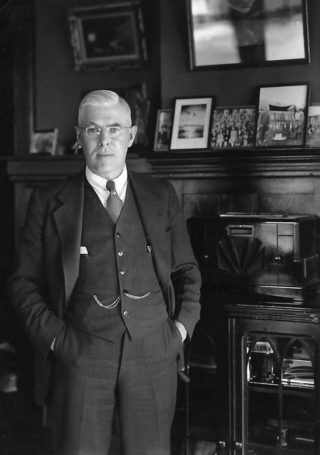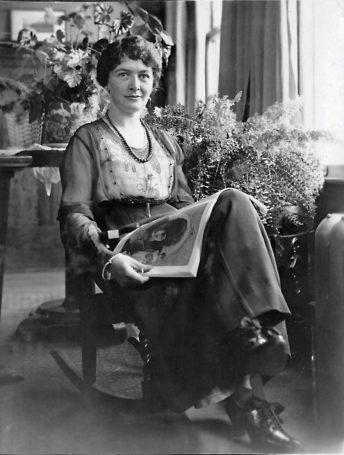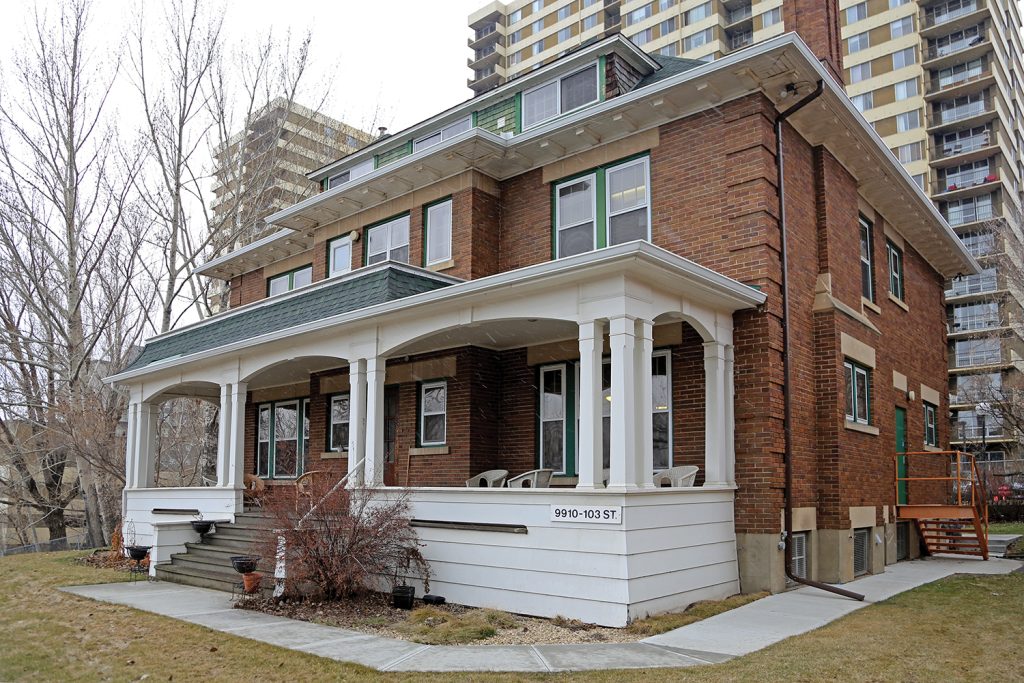Hilltop House: A gracious Echo of City’s Past
Hilltop House, from its vantage point on the north bank of the North Saskatchewan River valley, has overlooked the growing city of Edmonton for more than a century.
The view from the two-and-a-half-storey mansion, located at 9910 103 Street, is nothing short of spectacular. On a fall day, a tranquil ocean of gold leaves stretches out below, as peaceful as if the busy city was just a rumour. The house sits above the valley that was a meeting place for Indigenous people for many generations, long before the arrival of Europeans. Today other, more recent, meeting places in that valley — the Muttart Conservatory and Gallagher Park spring to mind — are common ground for Edmontonians from all walks of life.
It seems fitting that Hilltop House, throughout its history, has also been a meeting place, entwined with the development of the surrounding community.
The house was built in 1913, for Sophie and John C. McDougall. John C. McDougall was the son of John A. McDougall, the former Edmonton mayor, MLA and well-known business owner. John C. worked for his father’s business, McDougall and Secord, as an administrator and accountant. Sophie was active in clubs and organizations, and the couple were enthusiastic entertainers, bringing together the who’s who of Edmonton.

The McDougalls lived in the house until 1953. In subsequent years it served as a drug treatment facility, a women’s shelter and provincial government offices. Since 2005, it has been the home of Edmonton Community Foundation (ECF). It stands today as a glimpse of the city’s past.
“I think [built heritage] is really important for our city,” says Tim O’Grady, president of the Edmonton and District Historical Society. “It’s one of the things that makes our city unique and really important in placemaking. It helps build community. Hilltop House is a good example of that.”
Although it is an important connection with the city’s past, Hilltop House is largely hidden from the daily stream of traffic to and from downtown. Access is from Slatter Way, rather than 103 Street, and it can be a bit tricky to find.
“Most people drive past it every day and have never really seen it,” says O’Grady. “You can kind of see it, but to get to it you have to go through this back way, and it’s just this cool little hidden gem.”
Stepping into Hilltop House is a bit like stepping back in time. Current owner ECF has retained as much of the character from the house’s early years as possible. A trip through the building echoes 1915 Edmonton and the issues of the day: the First World War, the women’s suffrage movement and the huge flood.
“I’m an Edmonton history nerd and I love to show off the house, and put it in context so that people know what they’re looking at,” says Elizabeth Bonkink, a communications advisor for ECF.
“It’s not just, ‘Oh, this is a lovely old place,’ right? This is the time of Pink Teas and women trying to get the vote — Sophie was a member of the Women’s Canadian Club of Edmonton. It was a unique time.
They were on the cusp of something … they were always waiting for the next thing, and I don’t think that sort of feeling about Edmonton has ever changed.”

Designed by architect David Hardie — who also designed the Hecla Block and Armstrong Block — the house is a four-square plan that was common for the period. It is an elegant building, clad in brick. A large verandah supplies a jaw-dropping view of the river valley.
The interior retains much of the feel of the original family home. A visitor will see the original dining room set, which was a recent gift from the McDougall family. They will also see the bold millwork and high ceilings found in the grand houses of the day, the magnificent front stairs and the mysterious-looking back stairs leading up to the bedrooms for family and staff. There is also the dumbwaiter,
a scene of mischief for kids playing hide-and-seek.
The McDougalls had one staff member at the house, a cook/housekeeper named Martha, who occasionally butted heads with her employer. “John C. was an avid photographer,” Bonkink said. “He was part of an adventurers club and he liked photography, so he had a studio — basically a place to develop his photos in the basement. He and Martha used to get into it because she’d be trying to do laundry while he was in the darkroom.” The couple, along with children Jack and Eleanor, lived a busy life in Hilltop House. John C. was known as a bit of a daredevil who enjoyed activities as diverse as mountaineering and flying with legendary Edmonton pilot Wop May. Closer to home, he hosted “Keg of the Month Club” gatherings and was famous for making maple fudge. Both he and Sophie were well-known for their hospitality.
John C. McDougall died in 1952 from a heart attack and Sophie left the house the following year, living until 1968.
Between 1953 and 1987 the house continued to function as an important meeting place, used as a drug treatment centre and a shelter for women who were victims of domestic violence.
Although we can’t know the names of all the people who came to Hilltop House for help during this time, they are as much a part of Edmonton’s story as its most prominent gentry. There is satisfaction in knowing that when they needed it most, they may have found comfort and hope at Hilltop House.
Between 1990 and 2003, the house was provincial office space, housing at different times the Premier’s Council in Support of Alberta Families and the Office of the Children’s Advocate. The house was left vacant in 2003 until its purchase by ECF in 2005.
Under ECF’s ownership, Hilltop House has continued to play its role enhancing the city. The Foundation acts as a bridge between donors and charities, supporting a vibrant culture of community-building. And as ECF has grown, so too has Hilltop House, although it retains its architectural connection to the city’s past.
“It’s such a cool example of adaptive reuse,” O’Grady says. “Good for them to keep [the heritage character] and deal with it so sympathetically and so appropriately. I think that speaks a lot to the organization and their values.”

In 2015, the original structure was complemented by an addition designed by Manasc Isaac Architects. It is in essence a second building, with a feeling of light and space. Anyone walking into the ECF offices today can see the addition gives a sense of new meeting old.
In 2019, ECF held an Open Doors event, welcoming approximately 75 people for a tour of the house and its history, researched by Bonkink and former historian laureate Shirley Lowe. The event even included staff members playing the McDougalls, inviting visitors for tea. It was a chance for guests to get a taste of 1915 Edmonton, to reflect on what has changed and what has remained constant.
Today, Hilltop House stands above the North Saskatchewan River as a symbol of Edmonton itself — a meeting place of people and ideas, woven into the fabric of the community.
